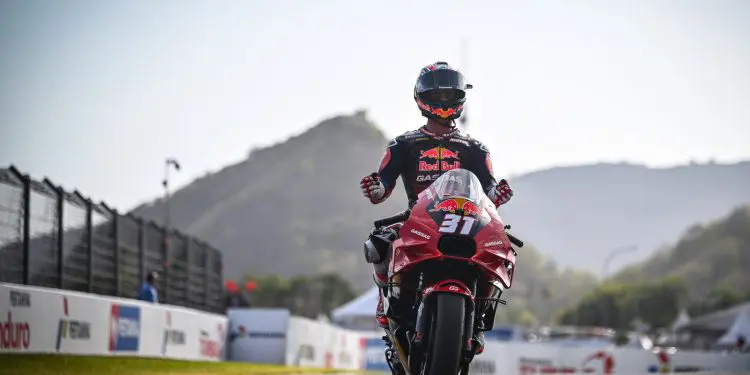The world of MotoGP is witnessing a pivotal transition, and Dorna, the governing body of MotoGP, knows this better than anyone. With Marc Márquez, their biggest star of the last decade, approaching the twilight of his illustrious career, they need to secure the next big figure to keep the MotoGP spectacle alive and thriving, particularly for the Spanish fans and sponsors that have long been the bedrock of the sport. Enter Pedro Acosta—a rising star, young, talented, and increasingly being positioned as the heir to the throne that Márquez will eventually vacate. But is this strategic move by Dorna a calculated gamble? Or is it a reflection of desperation, knowing that their golden boy, Márquez, won’t last forever?
Pedro Acosta has been nothing short of phenomenal since his entrance into the world of MotoGP. From winning the Moto3 championship in his debut year to dominating Moto2 and now making headlines in his rookie season in MotoGP, Acosta has done it all with ease and flair. His raw talent, combined with his ability to stay calm under pressure, has made him a magnet for attention, both on and off the track. Dorna, recognizing the impending void that Márquez’s decline will create, has been quick to elevate Acosta as their next big headline act.
However, there’s more to this story than simply promoting a promising young rider. Márquez has been a once-in-a-lifetime talent, dominating the sport with his aggressive riding style and fearless attitude. His presence has not only captivated fans but has been a massive pull for sponsors. The prospect of losing such a figure is daunting for Dorna, and there’s an evident push to ensure that Acosta is ready to step into that massive spotlight.
This isn’t just about filling a seat—it’s about filling a void that extends beyond the race track. The Spanish market has long been the heart of MotoGP’s fan base, and with Márquez eventually stepping back, the onus is on Acosta to carry that legacy forward. As we know, sports aren’t just about the athletes—they are about national pride, sponsorship dollars, and keeping the machinery of marketing moving. Márquez has been the poster boy for this, and now, Acosta is being primed to take over.
The urgency behind Dorna’s need to promote Acosta becomes even clearer when considering the recent shifts in MotoGP’s power structure. The grid has seen more diversity in talent, with the likes of Italian Francesco Bagnaia and Frenchman Fabio Quartararo winning world titles, breaking Spain’s long dominance in the sport. While this global expansion of talent is excellent for the sport’s international appeal, Dorna knows that they must maintain strong Spanish representation to keep their core audience engaged. This is why Acosta, as young as he is, finds himself at the center of their marketing strategy.
In recent races, Acosta’s performances have been highly scrutinized, and each of his achievements has been celebrated as part of this overarching narrative. Whether it’s his consistent podium finishes or his fearless approach to challenging established stars like Bagnaia and Jorge Martín, Dorna has ensured that the spotlight remains firmly on him. With Márquez still in the picture, albeit hampered by injuries and inconsistent form, there’s a clear sense that the torch is being passed gradually. Dorna wants to build the Acosta brand now, so that by the time Márquez steps aside, they already have their next superstar ready to fill his shoes.
There’s also the sponsorship factor. MotoGP is an expensive sport, and sponsors want to back winners who also bring visibility. Márquez has been that golden boy for years, drawing in significant commercial support. Acosta’s rise, therefore, isn’t just about sporting performance—it’s a business decision. If Dorna can create the next Spanish superstar, they will keep their sponsors happy, maintain television ratings, and continue to drive interest from Spanish fans, who have historically been the backbone of MotoGP’s popularity.
However, the question remains: Is Dorna moving too fast with Acosta? Despite his remarkable achievements, Acosta is still a rookie in the premier class. His early performances in MotoGP have been impressive, but he is not yet the finished article. Some argue that Dorna’s rush to position him as the next big thing could place undue pressure on the young rider, which might hamper his development in the long term.
Moreover, comparisons between Acosta and Márquez, or even other legends like Valentino Rossi and Casey Stoner, are inevitable, but they may be premature. Márquez’s dominance was unique, built on a style of racing that hasn’t been easily replicated. Acosta, on the other hand, has shown a more calculated and measured approach, which, while effective, doesn’t yet have the same all-or-nothing flair that made Márquez a global sensation. Dorna’s hope is that Acosta can blend the best of both worlds—a fearless competitor on the track, but one who avoids the injury pitfalls that have plagued Márquez’s later years.
In conclusion, Dorna’s promotion of Pedro Acosta as the next face of MotoGP is not just a response to his undeniable talent—it’s a strategic necessity. The shadow of Marc Márquez looms large over the sport, and Dorna knows that without another Spanish superstar, they risk losing the core audience and sponsors that have supported MotoGP for decades. While Acosta’s journey is still in its early stages, the groundwork is being laid for him to become the next great icon of the sport. Whether he can handle the immense pressure and expectations remains to be seen, but one thing is certain: Dorna is betting heavily on the young Spaniard to keep the wheels of MotoGP spinning smoothly into the future.






